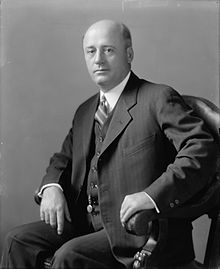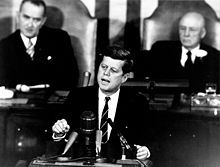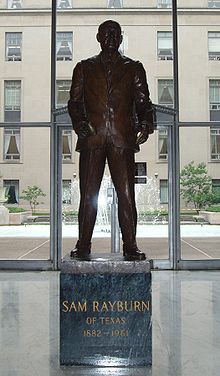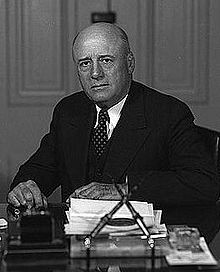- Sam Rayburn
-
For the football player, see Sam Rayburn (American football).
Samuel Taliaferro Rayburn 
48th, 50th and 52nd Speaker of the United States House of Representatives In office
January 3, 1955 – November 17, 1961President Dwight D. Eisenhower
John F. KennedyPreceded by Joseph William Martin, Jr. Succeeded by John William McCormack In office
January 3, 1949 – January 3, 1953President Harry S. Truman Preceded by Joseph William Martin, Jr. Succeeded by Joseph William Martin, Jr. In office
September 16, 1940 – January 3, 1947President Franklin D. Roosevelt
Harry S. TrumanPreceded by William B. Bankhead Succeeded by Joseph William Martin, Jr. House Minority Leader In office
January 3, 1953 – January 3, 1955Deputy John William McCormack Preceded by Joseph William Martin, Jr. Succeeded by Joseph William Martin, Jr. In office
January 3, 1947 – January 3, 1949Deputy John William McCormack Preceded by Joseph William Martin, Jr. Succeeded by Joseph William Martin, Jr. House Majority Leader In office
January 3, 1937 – September 16, 1940Deputy Patrick J. Boland Preceded by William B. Bankhead Succeeded by John William McCormack Member of the
U.S. House of Representatives from
Texas's 4th districtIn office
March 4, 1913 – November 17, 1961Preceded by Choice B. Randell Succeeded by Ray Roberts Personal details Born January 6, 1882
Kingston, TennesseeDied November 16, 1961 (aged 79)
Bonham, TexasPolitical party Democratic Alma mater Texas A&M University–Commerce Profession Law Religion Primitive Baptist Samuel Taliaferro Rayburn (January 6, 1882 – November 16, 1961), often called "Mr. Sam," or "Mr. Democrat,"[1] was a Democratic lawmaker from Bonham, Texas, who served as the Speaker of the U.S. House of Representatives for seventeen years, the longest tenure in U.S. history.
Contents
Background
Rayburn was born in Roane County, Tennessee, and was baptized by Elder H.G. Ball in the Primitive Baptist Church, also known as Old Line Baptist or Hard Shell Baptist Church. Rayburn graduated from Mayo College (now Texas A&M University-Commerce) in Commerce, which was located in northeast Texas. He attended the University of Texas School of Law while teaching school, and was admitted to the State Bar of Texas in 1908. Just after being admitted to the bar, he won election to the Texas House of Representatives, beginning his first term in 1909. During his second two-year term in the Texas House, he was elected Speaker of the House at the age of twenty-nine. The next year, he won election to the United States House of Representatives in District 4. He entered Congress in 1913 at the beginning of Woodrow Wilson's presidency and served in office for almost forty-nine years (more than twenty-four terms), until the beginning of John F. Kennedy's presidency.
Personal life
Though a menacing and powerful presence on the House floor, Rayburn was incredibly shy outside of work.
He had married once, to Metze Jones (1897–1982), sister of Texas Congressman Marvin Jones and Rayburn's colleague, but the marriage ended quickly, though no reason was given. Biographer D.B. Hardeman guessed that Rayburn's work schedule and long bachelorhood, combined with the couple's differing views on alcohol, contributed to the rift. The court's divorce file in Bonham, Texas, has never been located, and Rayburn avoided speaking of his brief marriage. One of his greatest, most painful regrets was that he did not have a son, or as he put it in Robert Caro's biography of Lyndon B. Johnson, "a towheaded boy to take fishing."
Speaker of the House
A statue of Rayburn in the Rayburn House Office Building
On September 16, 1940 at the age of 58, and while serving as Majority Leader of the United States House of Representatives, Rayburn became Speaker of the House upon the sudden death of Speaker William Bankhead. Rayburn's career as Speaker was interrupted only twice: 1947–1949 and 1953–1955, when Republicans controlled the House. During those periods of Republican rule, Rayburn served as Minority Leader. However, he so disliked the term "minority leader" that he asked to be referred to as the "Democratic Leader" during those interim four years when the office of Speaker was held by the Republican Joseph W. Martin, Jr. of Massachusetts, actually a close personal friend of Rayburn's.[2]
Himself a protege of Vice President of the United States John Nance Garner, Rayburn was a close friend and mentor of Lyndon B. Johnson and knew Johnson's father Sam from their days in the Texas Legislature. Rayburn was instrumental to LBJ's ascent to power, particularly his unusual and rapid rise to the position of Minority Leader; Johnson had been in the Senate for a mere four years when he assumed the role. Johnson also owed his subsequent elevation to Majority Leader to Rayburn. Like Johnson, Rayburn did not sign the Southern Manifesto.[3]
Also, as Speaker of the House, in the interest of the United States of America, Rayburn forged close friendships and partnerships with legislatures of emerging independent countries and democracies on the continent of Africa, especially Nigeria, a rising political power on that continent. Rayburn was a good friend of The Honorable Jaja Wachuku, who was the first indigenous Speaker of the Nigerian House of Representatives, from 1959 to 1960.
Personal integrity
Although many Texas legislators were on the payroll of public service corporations, Rayburn refused to do so. As he recounted in a speech during his congressional campaign:
"When I became a member of the law firm of Steger, Thurmond and Rayburn, Messrs. Thurmond and Steger were representing the Santa Fe Railroad Company, receiving pay monthly. When the first check came after I entered the firm, Mr. Thurmond brought to my desk one-third of the amount of the check, explaining what it was for. I said to him that I was a member of the Legislature, representing the people of Fannin County, and that my experience had taught me that men who represent the people should be as far removed as possible from concerns whose interests he was liable to be called on to legislate concerning, and that on that ground I would not accept a dollar of the railroad's money, though I was legally entitled to it. I never did take a dollar of it. I have been guided by the principle in all my dealings."[4]
This practice of refusing to accept fees from clients who had interests before the Legislature was "virtually unheard-of" at the time.[5] Later, while serving in Congress, a wealthy oil man had a very expensive horse delivered to Rayburn's farm in Bonham. No one apparently knew the oil man delivered the horse except him, Rayburn, and a Rayburn staffer. Rayburn returned the horse.[6]
Legendary reputation
In shaping legislation, Rayburn preferred working quietly in the background to being in the public spotlight. As Speaker, he won a reputation for fairness and integrity. In his years in Congress, Rayburn always insisted on paying his own expenses, even going so far as to pay for his own travel expenses when inspecting the Panama Canal when his committee was considering legislation concerning it, rather than exercising his right to have the government pay for it. When he died, his personal savings totaled only $15,000, and most of his holdings were in his family ranch.
Rayburn was well known among his colleagues for his after business hours "Board of Education" meetings in hideaway offices in the House. During these off-the-record sessions, the Speaker and powerful committee chairmen would gather for poker, bourbon, and a frank discussion of politics. Rayburn alone determined who received an invitation to these gatherings; to be invited to a "Board of Education" gathering was a high honor.
He coined the term "Sun Belt" while strongly supporting the construction of Route 66. It originally ran south from Chicago, through Oklahoma, and then turned westward from Texas to New Mexico and Arizona before ending at the beach in Santa Monica, California. Arguing in favor of the project, he stated famously that America absolutely must connect "the Frost Belt with the Sun Belt."
Rayburn also had a knack for dressing to suit his occasion. While in Washington, D.C., he would sport expensive suits, starched shirts, and perfectly shined shoes. However, while back in his poorer district in Texas, Rayburn would wear simple shirts, blue jeans, cowboy boots, and cowboy hats. Several politicians have imitated this pattern, including Ronald Reagan's famous example of clearing brush when at home in California, while wearing fine suits in Washington.
The phrase "A jackass can kick a barn down, but it takes a carpenter to build one," is attributed to Rayburn.[7]
James Roosevelt, a U.S. representative from California and a son of Franklin and Eleanor Roosevelt, once called Rayburn "the most impressive person in Congress." Rayburn had urged James not to follow in the footsteps of his brother, Representative Franklin D. Roosevelt, Jr., of New York, whom Rayburn considered not to have taken seriously his duties of office. Thomas Abernethy of Mississippi said that Rayburn was the most influential Speaker in history because he could "work with liberals and conservatives, ran the House with a firm hand but was generous."[2] William Colmer, another Mississippian and the mentor of later Representative and U.S. Senator Trent Lott, described Rayburn as a "very strong parliamentarian" who was far more effective than his successor, John McCormack of Massachusetts, whom Colmer found "wanted to be liked" by his colleagues.[2]
 Speaker Rayburn is seated at right behind President John F. Kennedy in this May 25, 1961 photograph showing Kennedy announcing the Apollo program.
Speaker Rayburn is seated at right behind President John F. Kennedy in this May 25, 1961 photograph showing Kennedy announcing the Apollo program.
Asked why he never sought the presidency, Rayburn said that he was "born in the wrong place at the wrong time" to undertake a national campaign.[2] Rayburn was Speaker at a time that the greater power in the House rested with committee chairmen. He was himself readily accessible to members; historian Anthony Champagne of the University of Texas at Dallas, a Rayburn scholar, views the Speaker as a "bridge between the northern and southern members" of the Democratic Party. Champagne recalled a report that Rayburn so understood the House that he was "married" to the body and could "feel the sentiment of the members" by merely being in their presence. He was careful to fight his own battles, Champagne said. Rayburn was a mentor to such younger members as Richard Bolling of Missouri, Wilbur D. Mills of Arkansas, Carl Albert of Oklahoma, and Homer Thornberry and Jack Brooks, both of Texas.[2] He was also readily accessible to constituents, who were invited to come to his home in Bonham and visit without prior notice.[2]
Rayburn died of pancreatic cancer in 1961 at the age of 79 and was posthumously awarded the Congressional Gold Medal. By the time of his death, he had served as Speaker for twice as long as any of his predecessors.
His home in Texas, now known as the Samuel T. Rayburn House, was designated a U.S. National Historic Landmark.
Tributes
 Stamp issued by the United States Postal Service commemorating Sam Rayburn.
Stamp issued by the United States Postal Service commemorating Sam Rayburn.
- The Rayburn House Office Building, which contains offices of House members adjacent to the United States Capitol.
- The ballistic missile submarine USS Sam Rayburn.
- The Sam Rayburn Reservoir in East Texas was named after him in 1963, and is a popular destination for bass fishing and professional fishing tournaments.
- Sam Rayburn High School in Pasadena, Texas, also bears his name and houses the desk he used as Speaker of the House.
- The Sam Rayburn Independent School District was named for him in 1964.
- A documentary tentatively titled "Rayburn: Mr. Speaker" is currently in production from filmmaker Reed Penney, according to a report by the Texas A&M University-Commerce campus newspaper The East Texan.
- Sam Rayburn Memorial Student Center at Texas A&M University-Commerce is named after Mr. Rayburn.
- Sam Rayburn Middle School in Bryan, Texas is named in his honor.
- Sam Rayburn Middle School in San Antonio, Texas was named in his honor.
- Sam Rayburn Parkway is a portion of U.S. Highway 75 that runs through Sherman, TX.
- Sam Rayburn Tollway is a toll road that goes through Dallas, Denton, and Collin counties in north Texas.[8]
- Sam Rayburn Memorial Highway, roughly a forty mile section of Texas State Highway 121 that begins at Texas State Highway 78, two miles north of Bonham, Texas, and ends at its terminus with the Sam Rayburn Tollway in McKinney, Texas, was named in his honor.
- Sam Rayburn Elementary School in McAllen, Texas is named in his honor.
- Sam Rayburn Memorial Veterans Center in Bonham, Texas was named in his honor.
- The Rayburn Room at The Greenbrier in White Sulphur Springs, West Virginia was named in his honor, as he was Speaker of the House during the decision to build the Bunker.
Portrayals
Pat Hingle played Rayburn in LBJ: The Early Years while James Gammon portrayed the Speaker in Truman.
See also
- Wahrenberger House
References
- ^ Dallas Morning News, October 10, 1961
- ^ a b c d e f Anthony Champagne, University of Texas at Dallas, "Sam Rayburn", West Texas Historical Association joint meeting with the East Texas Historical Association in Fort Worth, February 26, 2010
- ^ Badger, Tony (1999). "Southerners Who Refused to Sign the Southern Manifesto". The Historical Journal 42 (2): 517–534. http://www.jstor.org/pss/3020998.
- ^ H.G. Dulaney & Edward Hake Phillips, Speak, Mr. Speaker 20 (1978)
- ^ Anthony Champagne, Congressman Sam Rayburn 32 (1984)
- ^ Anthony Champagne, Congressman Sam Rayburn 31 (1984)
- ^ Time - The Prelude of the 83rd
- ^ [1]
Further reading
- Robert A. Caro, The Years of Lyndon Johnson: The Path to Power (1982).
- Anthony Champagne and Floyd F. Ewing, "RAYBURN, SAMUEL TALIAFERRO (1882-1961)." Handbook of Texas Online (2005) online version
- Anthony Champagne, Congressman Sam Rayburn (Rutgers University Press, 1984).
- Anthony Champagne, Sam Rayburn: A Bio-Bibliography (Greenwood, 1988).
- C. Dwight Dorough, Mr. Sam (1962).
- Lewis L. Gould and Nancy Beck Young, "The Speaker and the Presidents: Sam Rayburn, the White House, and the Legislative Process, 1941–1961" in Raymond W. Smock and Susan W. Hammond, eds. Masters of the House: Congressional Leadership Over Two Centuries (1998). online version
- D. B. Hardeman and Donald C. Bacon, Rayburn: A Biography (Austin: Texas Monthly Press, 1987).
- Alfred Steinberg, Sam Rayburn (Hawthorn, 1975)
External links
- Obituary, NY Times, November 16, 1961, Rayburn Is Dead; Served 17 Years As House Speaker
- The leadership of Speaker Sam Rayburn published 1961, hosted by the Portal to Texas History.
- Sam Rayburn at the Biographical Directory of the United States Congress
- Samuel Taliaferro Rayburn from the Handbook of Texas Online
- "Mister Speaker", Time Magazine, September 27, 1943
- Rayburn: Mr Speaker Documentary Website
- The Friends of Sam Rayburn Website
- Sam Rayburn at Find a Grave
- Address Delivered by The Honorable Sam Rayburn at the Dedication of the Marker over the Graves of His Great-Great Grandfather Col. George Waller and his wife Ann Winston Carr, Oakwood Cemetery, Martinsville, Virginia, May 6, 1951
Speakers of the United States House of Representatives Muhlenberg · Trumbull · Muhlenberg · Dayton · Sedgwick · Macon · Varnum · Clay · Cheves · Clay · Taylor · Barbour · Clay · Taylor · Stevenson · Bell · Polk · Hunter · White · Jones · Davis · Winthrop · Cobb · Boyd · Banks · Orr · Pennington · Grow · Colfax · Pomeroy · Blaine · Kerr · Randall · Keifer · Carlisle · Reed · Crisp · Reed · Henderson · Cannon · Clark · Gillett · Longworth · Garner · Rainey · Byrns · Bankhead · Rayburn · Martin · Rayburn · Martin · Rayburn · McCormack · Albert · O'Neill · Wright · Foley · Gingrich · Hastert · Pelosi · BoehnerMajority Leaders of the United States House of Representatives Minority Leaders of the United States House of Representatives Democratic Party Leaders in the United States House of Representatives Speakers of the Texas House of Representatives Crump · Brown · Branch · Crump · Bourland · Perkins · Henderson · Keenan · Dickson · Runnels · Bee · W. Taylor · Locke · M. Taylor · Buckley · Darnell · Buckley · M. Taylor · Burford · Evans · Sinclair · M. Taylor · Bryan · Bonner · Cochran · Reeves · Gibson · Foster · Pendleton · Alexander · Milner · Cochran · Smith · Dashiell · Sherrill · Prince · Neff · Seabury · Love · Kennedy · Marshall · Rayburn · Terrell · Woods · Fuller · Thomason · Thomas · Seagler · Satterwhite · Bobbitt · Barron · Minor · Stevenson · Calvert · Morse · Leonard · Daniel · Gilmer · Reed · Manford · Senterfitt · Lindsey · Carr · Turman · Tunnell · Barnes · Mutscher · Slider · Price · Daniel, Jr. · Clayton · Lewis · Laney · Craddick · Straus
 Categories:
Categories:- 1882 births
- 1961 deaths
- Baptists from the United States
- Cancer deaths in Texas
- Congressional Gold Medal recipients
- Deaths from pancreatic cancer
- Majority Leaders of the United States House of Representatives
- Members of the Texas House of Representatives
- Members of the United States House of Representatives from Texas
- Minority Leaders of the United States House of Representatives
- People from Roane County, Tennessee
- Speakers of the Texas House of Representatives
- Speakers of the United States House of Representatives
- Texas A&M University–Commerce alumni
- Texas Democrats
- United States presidential candidates, 1956
Wikimedia Foundation. 2010.




